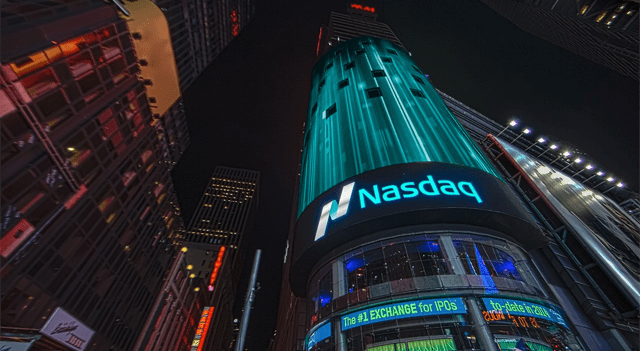U.S. futures were steady on Thursday as investors weighed a series of pivotal developments — from the Federal Reserve’s latest interest rate decision to a rare meeting between Donald Trump and Xi Jinping, and blockbuster earnings from major tech firms expanding their artificial intelligence ambitions.
Wall Street pauses after volatile session
By 03:43 ET, Dow futures slipped 26 points (0.1%), while S&P 500 and Nasdaq 100 futures were both marginally lower. The cautious start followed a mixed close on Wednesday: the Dow Jones Industrial Average eased 0.2%, the S&P 500 ended flat, and the Nasdaq Composite gained 0.6%, lifted by Nvidia’s (NASDAQ:NVDA) record-breaking rally that made it the first company valued at $5 trillion.
Earnings momentum also continued to shape sentiment. Caterpillar (NYSE:CAT) delivered stronger-than-expected third-quarter results, sending its shares up 11.6% and providing a rare boost to industrial names.
Fed trims rates again but warns against overconfidence
The Federal Reserve lowered its benchmark rate by 25 basis points to a range of 3.75%–4.00% on Wednesday, marking its third rate cut of 2025. The move was widely anticipated, but policymakers offered little clarity on what comes next amid a data blackout caused by the U.S. government shutdown.
Divisions within the central bank became evident: Fed Governor Stephen Miran, a Trump appointee, pushed for a 50-basis-point cut, while Kansas City Fed President Jeffery Schmid argued for keeping rates unchanged.
At his post-meeting press conference, Chair Jerome Powell stressed that another rate move in December was “far from” guaranteed, prompting traders to scale back expectations for another reduction — pricing in a 71% probability, down from 90% earlier.
Powell also confirmed that the Fed would end its quantitative tightening program, halting the runoff of Treasuries and mortgage-backed securities due to tensions in overnight funding markets.
Elsewhere, the Bank of Japan left its policy stance intact but reiterated plans to gradually raise rates if conditions warrant. Meanwhile, the European Central Bank is expected to hold rates steady at 2%, with Christine Lagarde noting last month that the ECB was “in a good place.”
Trump and Xi strike a cautious trade understanding
Trade policy returned to center stage as President Donald Trump met Chinese President Xi Jinping in Busan, South Korea, for the first time in six years. Trump called the talks “amazing” and said the two sides reached a one-year agreement covering rare earths and critical minerals, alongside a 10% cut in fentanyl-related tariffs.
In return, Beijing pledged to tackle the export of chemicals used in fentanyl production and to pause restrictions on rare earth minerals, a critical input for electric vehicle and semiconductor industries. Trump added that China would start buying “tremendous amounts” of *U.S. soybeans and farm goods “starting immediately.”
The Chinese Commerce Ministry confirmed the one-year pause on rare earth restrictions and a mutual understanding on fentanyl and agricultural trade.
Trump said Nvidia’s Blackwell AI chip was not discussed, clarifying that the company’s future in China — a $50 billion market — remains “in the company’s hands.”
Following the 90-minute meeting, analysts at Vital Knowledge observed that “the deliverables don’t really alter the status quo” of U.S.-China trade dynamics.
Mega-cap tech earnings underline AI spending boom
Investors also turned their attention to a wave of results from the largest U.S. technology firms, with Meta Platforms (NASDAQ:META), Alphabet (NASDAQ:GOOG), and Microsoft (NASDAQ:MSFT) reporting late Wednesday, and Apple (NASDAQ:AAPL) and Amazon (NASDAQ:AMZN) due next.
Meta shares tumbled over 7% after-hours after the company said it would “aggressively” boost spending on developing AI that could surpass human intelligence. The announcement spooked investors already wary of mounting costs. Although revenue hit a record high, the company missed profit forecasts due to a tax liability from Trump’s budget legislation.
Alphabet, the parent of Google, posted record quarterly revenue and a 33% jump in profit to $35 billion, supported by strong results in cloud computing and digital advertising. Shares rose 7% in extended trading.
Microsoft also reported robust demand for its cloud and AI services, revealing plans to double data center capacity over the next two years. However, management cautioned that AI-related expenses will exceed prior estimates, pushing shares 2% lower after-hours.
Market analysts have warned that the industry’s aggressive spending cycle could eventually spark an AI-driven valuation bubble reminiscent of the dot-com boom.
OpenAI eyes record-breaking IPO
Adding to the sector’s momentum, Reuters reported that OpenAI is preparing for an initial public offering in 2027 that could value the company at up to $1 trillion, making it potentially the largest IPO ever.
The company plans to raise at least $60 billion, with a formal filing expected in the second half of 2026, the report said. Such an offering would give CEO Sam Altman substantial resources to advance his vision for artificial general intelligence.
The ChatGPT maker has already committed hundreds of billions of dollars to AI chip and infrastructure investments. Earlier this week, OpenAI finalized a deal with Microsoft, its largest backer, allowing it to transition into a for-profit structure to fund future expansion.
Meta stock price
Alphabet stock price
Microsoft stock price
Amazon stock price
